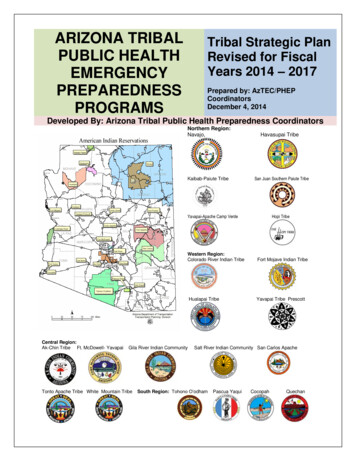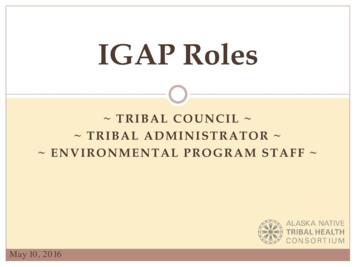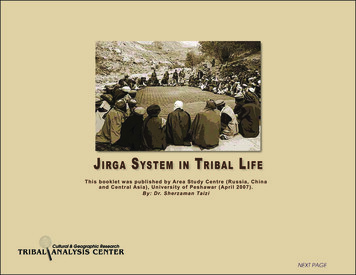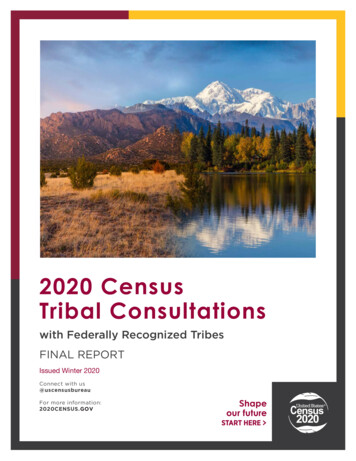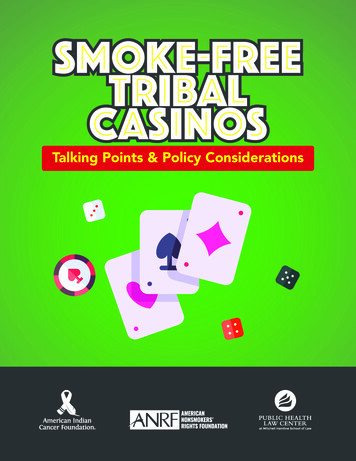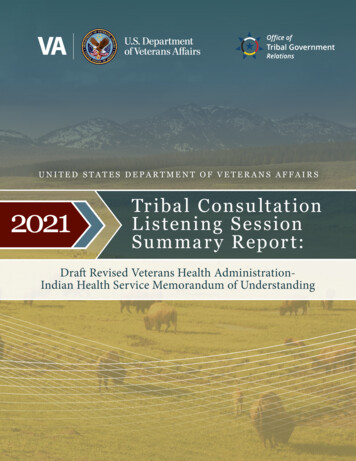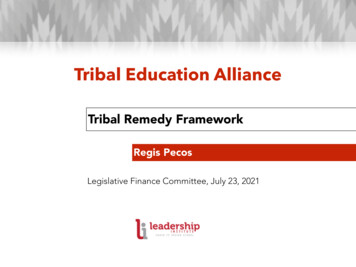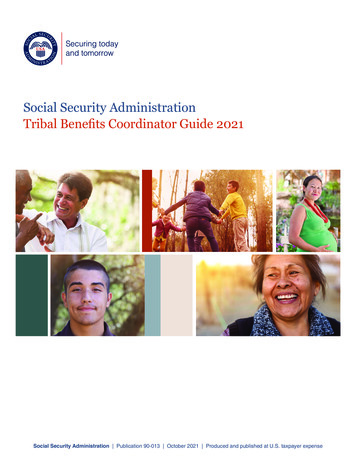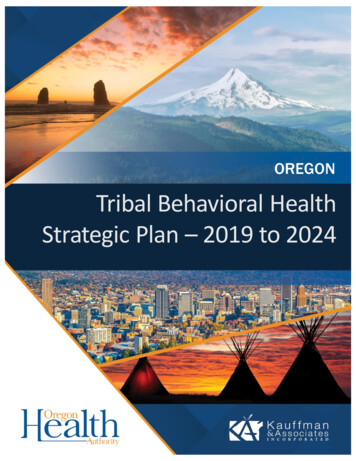
Transcription
OREGONTribal Behavioral HealthStrategic Plan – 2019 to 2024TRIBAL BEHAVIORAL HEALTH STRATEGIC ACTION PLAN
OREGONTribal Behavioral HealthStrategic Plan – 2019 to 2024Table of ContentsAcknowledgements. iiIntroduction . 1Current Reality . 2OHA Policies and Structure . 3Partnership between Tribes and CCOs . 3Strategic Plan 2019 to 2024 . 4Shared Vision . 4Challenges . 5Strategic Pillars. 6Strategic Outcomes . 6Strategic Action Steps . 8Training and credentialing . 8Tribal-based practices . 10Efficient data systems . 11Tribal consultation policy . 13Governance and financing . 14Next Steps . 16Appendix A: Strategic Planning Participants. 17TRIBAL BEHAVIORAL HEALTH STRATEGIC ACTION PLANi
OREGONTribal Behavioral HealthStrategic Plan – 2019 to 2024AcknowledgementsThe Oregon Health Authority would like to acknowledge those who participated in thedevelopment of this plan. Participants of the strategic planning workshop held March 7–8,2019, in Portland, OR, include representatives from: Confederated Tribes of Coos, Lower Umpqua, and Siuslaw IndiansConfederated Tribes of Grand RondeConfederated Tribes of Siletz IndiansConfederated Tribes of Warm SpringsCoquille Indian TribeCow Creek Band of Umpqua Tribe of IndiansKlamath TribesYellowhawk Tribal Health Center (Confederated Tribes of the Umatilla IndianReservation)Native American Rehabilitation Association of the Northwest (NARA)Northwest Portland Area Indian Health Board (NPAIHB)Oregon Health AuthorityOregon Department of Human Services (DHS) Office of Tribal AffairsThe Oregon Health Authority contracted with Kauffman & Associates, Inc. (KAI), to facilitate a strategic planningsession for the Oregon Native American Behavioral Health Collaborative. KAI is an American Indian-ownedmanagement firm dedicated to improving the lives of vulnerable populations and enhancing the reach andeffectiveness of caring organizations. At KAI, we do work that matters. www.kauffmaninc.comTRIBAL BEHAVIORAL HEALTH STRATEGIC ACTION PLANii
OREGONTribal Behavioral HealthStrategic Plan – 2019 to 2024IntroductionThe Oregon Health Authority (OHA) administers the state’s Medicaid program, fundscommunity-based health care services, and manages the Substance Use and Mental HealthBlock Grant. The grant supports substance misuse prevention, treatment, and recovery foruninsured or underinsured people, including the many people who receive health care servicesoperated by the federally recognized tribes in Oregon or the Native American RehabilitationAssociation of the Northwest (NARA). OHA is working to enhance health outcomes in Oregon byimproving access for all Oregon citizens to behavioral health care services and integratingbehavioral health care seamlessly with other health care services.In 2016, OHA assembled a statebehavioral health collaborativeto improve systems of care inOregon. In response to thiseffort, Oregon tribes, NARA, andthe Northwest Portland AreaIndian Health Board (NPAIHB)articulated a need tocollaboratively addressbehavioral health care needs inOregon tribal communities andmore specifically andappropriately respond to theunique systems operated in thecommunities they represent.As part of its overall efforts toA list of Oregon tribes on the wall at the NARA Wellness Centerimprove behavioral health careacross Oregon, OHA is committed to upholding the government-to-government relationshipwith tribes and collaborating with tribal governments and urban Indian health programs toreduce disparities in health outcomes and access to care for American Indians and AlaskaNatives in Oregon. OHA acknowledges that tribal and urban Indian health programs are keyproviders with the cultural understanding to address behavioral health in their communitiesand to strengthen their nations.The nine tribal nations in Oregon are: Burns Paiute TribeConfederated Tribes of Coos, Lower Umpqua, and Siuslaw IndiansConfederated Tribes of Grand RondeConfederated Tribes of Siletz IndiansTRIBAL BEHAVIORAL HEALTH STRATEGIC ACTION PLAN1
OREGONTribal Behavioral HealthStrategic Plan – 2019 to 2024 Confederated Tribes of the Umatilla Indian ReservationConfederated Tribes of Warm SpringsCoquille Indian TribeCow Creek Band of Umpqua Tribe of IndiansKlamath TribesNARA is the urban Indian health program in Portland, OR. Representatives from the nine tribalorganizations, NARA, OHA, the Oregon DHS Office of Tribal Affairs, and the NPAIHB form theOregon Native American Behavioral Health Collaborative, which works to improve behavioralhealth for tribal communities in Oregon.On March 7 and 8, 2019, the Oregon Native American Behavioral Health Collaborativeconvened to address behavioral health among American Indian and Alaska Native (AI/AN)people in Oregon. In preparation for the in-depth strategic planning session, OHA tribal affairsstaff met with behavioral health administrators from NARA and several Oregon tribes onFebruary 7, 2019, at OHA offices in Salem, OR. During the pre-planning meeting, the groupreviewed an environmental scan to understand the current reality of Oregon’s behavioralhealth care system broadly and in Indian Country, and began to develop a vision for thestrategic plan. During the strategic planning session in March, the group defined their vision ofsuccess, identified obstacles to achieving it, and developed strategic pillars and strategicoutcomes that articulate how we will work collaboratively to achieve our shared vision.Current RealityThe AI/AN population in Oregon experiences the same behavioral health challenges that arecommon across the state, such as substance misuse and depression, but they face significantdisparities in morbidity, mortality, health outcomes, and access to care. For example, in a 2014study1, the NPAIHB Northwest Tribal Epidemiology Center found the following informationpertaining to behavioral health disparities for AI/AN people. From 2006–2010, deaths from suicide were higher for AI/AN people (2.8%) than non-Hispanic Whitepeople (1.9%) in Oregon andsuicide rates for AI/AN youth ages 10 to 19 were 2.8 times higher than rates amongnon-Hispanic White youth in the same age group.1NPAIHB Northwest Tribal Epidemiology Center. (2014). Oregon American Indian & Alaska Native CommunityHealth Profile. Retrieved from:http://www.npaihb.org/images/epicenter docs/IDEA/2014/OrReports/OR%20THP%20Final Full%20Report.pdfTRIBAL BEHAVIORAL HEALTH STRATEGIC ACTION PLAN2
OREGONTribal Behavioral HealthStrategic Plan – 2019 to 2024 From 2006–2012, more AI/AN women (42%) than non-Hispanic White women (36%) reported feelingdepressed or in poor mental health in the previous month;despite 26% of AI/AN men reporting high levels of depression or poor mental health,only 1.3% of AI/AN men said they received treatment for a mental health condition;andAI/AN women were more than twice as likely to binge drink (35%) than non-HispanicWhite women (15%).AI/AN people can access health care through tribal, urban Indian, or IHS programs. Theavailable services vary by program. Tribes and urban Indian health programs have developedfully integrated behavioral health services within their care systems. As the state works toimprove behavioral health, it is important to fully consider, consult with, and integratetribal/urban care providers in meaningful and appropriate ways, to honor tribal-based practicesand ensure these providers receive the needed funding to continue providing effective services.In their response to the state behavioral health collaborative, Oregon tribes, NARA, and theNPAIHB recommended several ways to improve behavioral health care in Indian Country,including development of this strategic plan.OHA Policies and StructureIn March 2018, OHA passed a new tribal consultation policy designed to more closely resemblethe CMS tribal consultation approach. The policy expands the state’s obligation to consult withtribes to any action that could affect tribes, rather than only applying to Medicaid-relateddecisions. Full implementation of this policy will mean a respectful government-to-governmentrelationship between OHA and tribes and meaningful collaboration with NARA.A reorganization within OHA placed substance use prevention work under the public healthdivision, separating it from substance use treatment and mental health. Following thereorganization, the OHA addictions and mental health/substance abuse prevention tribal liaisonshifted to managing tribal affairs for OHA overall, and the original position was not replaced.Expansion of the tribal affairs department to offer a liaison specifically for the intersections ofOHA’s behavioral health work with tribes and NARA would support the collaborative’s workmoving forward.Partnership between Tribes and CCOsCoordinated Care Organizations (CCOs) provide much of the health care for Oregon Health Planmembers. CCOs are provider networks at the community level that work to integrate physical,behavioral, and dental health care.Currently, only three tribes have contracts with CCOs. Additional partnerships between tribesand CCOs could be mutually beneficial for care providers and consumers. Including tribal andTRIBAL BEHAVIORAL HEALTH STRATEGIC ACTION PLAN3
OREGONTribal Behavioral HealthStrategic Plan – 2019 to 2024urban providers in the CCO network would improve reimbursement from Medicaid at no costto the CCO or the state and increase much-needed coverage for vulnerable populations servedby tribal and NARA providers. Tribal and NARA provider systems must be incorporated into theCCO network in meaningful ways so that local efforts to provide seamless, integrated care isavailable, reimbursable, and culturally appropriate.The Oregon 1115 Waiver, Attachment I—Tribal Engagement and Collaboration Protocol,outlines how CCOs should work with tribes for Medicaid programs, including provisions fortraining and contracting and a requirement that each CCO have a tribal liaison. Other ways tointegrate tribes and NARA into the CCO system in the future include establishing a tribaladvisory council to assist in holding CCOs accountable for meeting Attachment I requirements,and including tribal representatives on CCO governing boards.Strategic Plan 2019 to 2024The Oregon Native American Behavioral Health Collaborative developed this strategic plan toenhance collaboration and overcome challenges to improve behavioral health in Indian Countryfor Oregon. As a foundation for the strategic plan, the group developed the following sharedvision, strategic pillars, and outcomes to guide their efforts.Shared VisionThe Oregon Native American Behavioral Health Collaborative developed the following vision tolead implementation efforts during the next 5-years:The Oregon Native American Behavioral Health Collaborativeenvisions healthy Native individuals, families, and communitiesthriving across Oregon. We envision a shared, continuous alliancebetween the state and tribal/urban providers that provides acontinuum of fully funded, comprehensive, culturally responsiveservices grounded in tribal-based practices and intertribalcollaboration at the administrative and clinical levels.TRIBAL BEHAVIORAL HEALTH STRATEGIC ACTION PLAN4
OREGONTribal Behavioral HealthStrategic Plan – 2019 to 2024Figure 1 is a visual representation of the shared vision, as depicted by strategic planningparticipants.Figure 1. A medicine wheel that represents the collaborative’s visionChallengesIt is important to understand our challenges to achieving this vision. The Oregon NativeAmerican Behavioral Health Collaborative examined the many challenges, obstacles, andcontradictions that prevent progress toward our shared vision. To achieve success, we mustovercome challenges in the following areas. Workforce: an underdeveloped workforce that is defined by non-Native cultureTraining: inadequate training, care, and support for the workforceCommunication: ineffective and inconsistent communicationDistance: geographic and time constraints that limit connections and accessCultural retraining of the state: a constant demand for training for the state andsecuring and maintaining respect for cultural practices;System fragmentation: fragmented, insensitive systems that do not follow a traumainformed approachPolitics: the impact of political turbulenceTribal-state relations: the ongoing relationship-building between the state andtribal/urban systemsTRIBAL BEHAVIORAL HEALTH STRATEGIC ACTION PLAN5
OREGONTribal Behavioral HealthStrategic Plan – 2019 to 2024For example, implementing systems through which tribes can train and accredit their ownworkforce will help create a culturally informed workforce. OHA and tribes/NARA can achieveeffective, consistent communication and strengthen their partnership through regular reportingand trainings for OHA and tribal leadership. The following sections of this document highlightthe shared vision and offer a detailed look at the strategic pillars and outcomes that outlinehow the collaborative will surmount these challenges.Participants collaborate on strategic planning considerationsStrategic PillarsThe Oregon Native American Behavioral Health Collaborative developed the following stra tegicpillars to support the shared vision.1.2.3.4.5.Training and credentialingTribal-based practicesEfficient data systemsTribal consultationGovernance and financeStrategic OutcomesThe Oregon Native American Behavioral Health Collaborative identified outcomes for eachpillar, listed in Table 1. These outcomes demonstrate an activity or result that can be measuredonce achieved. Additionally, each strategic pillar and outcome focuses on an identified tribalbest practice outlined in Figure 1.TRIBAL BEHAVIORAL HEALTH STRATEGIC ACTION PLAN6
OREGONTribal Behavioral HealthStrategic Plan – 2019 to 2024Table 1. Strategic outcomes for each strategic pillarStrategic PillarStrategic Outcomes1. Establish an accredited tribal learning center approved by MentalHealth & Addiction Certification Board of Oregon (MHACBO)Training and2.Secure funds to develop a qualified tribal workforce to provide a totalcredentialing (TC)continuum of care3. Create a tribal credentialing system to achieve sustainability fortribal-based behavioral healthTribal-basedpractices (TBP)1. Create a permanent rule or statute in support of tribal-basedpractices2. Secure state funding for technical assistance in implementing tribalbased practices3. Develop a centralized database of tribal-based practicesEfficient datasystems (DS)1. Conduct an inventory of all baseline behavioral health data fromstate, federal, tribal, and local resources2. Create and identify culturally relevant, specific tribal behavioralhealth metricsTribalconsultationpolicy (TCP)1. Establish regular information sharing between the state and tribes2. Provide comprehensive, mandatory annual training for all stateemployees on how to appropriately engage with tribes3. Clarify the relationships and expectations between CCOs andtribes/NARAGovernance andfinance (GF)1. Ensure adequate tribal representation on regional governanceentities, with required metrics and reports2. Establish a dedicated funding set-aside for tribal and urban programsto provide adequate, flexible funding3. Maintain the existing tribal billing structure, including encounterrates and the fee-for-service system, and expand reimbursementcodesTRIBAL BEHAVIORAL HEALTH STRATEGIC ACTION PLAN7
OREGONTribal Behavioral HealthStrategic Plan – 2019 to 2024Strategic Action StepsTable 2 through Table 6 list the strategic action steps the Oregon Native American BehavioralHealth Collaborative outlined to achieve the intended outcomes of each strategic pillar. Foreach action step, the tables list who needs to be involved and the completion timeframe.The action steps are coded by the acronym of the strategic pillar and numbered by theoutcome. For example, the first strategic pillar is training and credentialing. This pillar’sacronym is TC. There are three outcomes under this strategic pillar. In the following action steptable, TC-1 refers to the first strategic pillar and the first outcome.Training and credentialingTo strengthen the tribal workforce and empower providers to offer culturally appropriate care,the Oregon Native American Behavioral Health Collaborative recommends establishing a tribalcredentialing system and an accredited tribal learning center. Another objective is to create abehavioral health tribal liaison position at OHA, with 25% of their time dedicated to workforcedevelopment.Table 2. Action steps to develop a training initiative and tribal credentialing systemOutcomeAction StepsKey PlayersTimeframeTC-1: Establish anaccredited triballearning centerapproved byMHACBOTC-1.1: Survey all Oregon tribesand urban Native Americanprograms to find trainersWenona Scott,Misty Kopplin,T.J. Foltz,Caroline Cruz,Laurie Dawkins,OHA triballiaisonJuly 2019TC-1.2: Create a master list oftrainersWenona Scott,Misty Kopplin,T.J. Foltz,Caroline Cruz,Laurie Dawkins,OHA triballiaisonAugust 2019TRIBAL BEHAVIORAL HEALTH STRATEGIC ACTION PLAN8
OREGONTribal Behavioral HealthStrategic Plan – 2019 to 2024OutcomeAction StepsKey PlayersTimeframeTC-1.3: Identify existing topicsand gapsWenona Scott,Misty Kopplin,T.J. Foltz,Caroline Cruz,Laurie Dawkins,OHA triballiaisonSeptember 2019TC-1.4: Set a schedule ofcohorts and classes throughoutthe stateWenona Scott,Misty Kopplin,T.J. Foltz,Caroline Cruz,Laurie Dawkins,OHA triballiaisonOctober 2019TC-2: Secure fundsto develop aqualified tribalworkforce toprovide a totalcontinuum of careTC-2.1: Meet with the OHAtribal affairs director and OHAleadership to include abehavioral health tribal liaisonposition at OHA, with 25% oftheir time dedicate to tribalworkforce development, anddedicated funds for trainingCaroline CruzMay 2019TC-3: Create atribal credentialingsystem to achievesustainability fortribal-basedbehavioral healthTC-3.1 Review the 22 tribalbased practices, including acrosswalk for clinical use, andseek tribal and federalrecognition and certificationBehavioralhealthdepartments ofthe 9 Oregontribes and NARASeptember 2019TC-3.2: Review all credentialrequirements for mental healthproviders and standardize tribalcredentialsBehavioralhealthdepartments ofthe 9 Oregontribes and NARAOctober 2019TRIBAL BEHAVIORAL HEALTH STRATEGIC ACTION PLAN9
OREGONTribal Behavioral HealthStrategic Plan – 2019 to 2024OutcomeAction StepsKey PlayersTimeframeTC-3.3: Develop a credentialingmatrix that enables fee-forservice billing with the OregonHealth Plan or other insuranceBehavioralhealthdepartments ofthe 9 Oregontribes and NARA,Jason StienerDecember 2019TC-3.4: Create a tribalcertification boardOregon tribes,NARA,NPAIHB,IHSMarch 2021TC-3.5: Sustain the negotiatedstate plan amendment forencounter ratesOregon tribes,NARA,the stateMarch 2021TC-3.6: Seek PL 93-638compacted funding for acommunity healthaccreditation program (CHAP)Oregon tribes,NARAMarch 2021Tribal-based practicesTo ensure tribes can continue to care for their people according to cultural best practices , thestate must support tribal-based practices through policy and funding. A peer-run technicalassistance team and database of tribal-based practices would further support this strategicpillar.Table 3. Action steps to reinstate and maintain tribal-based practicesOutcomeAction StepsKey PlayersTimeframeTBP-1: Create apermanent rule orstatute in supportof tribal-basedpracticesTBP-1.1: Amend statelegislation to include strongerlanguage for tribal-basedpractices and support acontinuum of care beyondpreventionNPAIHB,Oregon tribes,a representativeto propose theamendmentJune 2023TRIBAL BEHAVIORAL HEALTH STRATEGIC ACTION PLAN10
OREGONTribal Behavioral HealthStrategic Plan – 2019 to 2024OutcomeAction StepsKey PlayersTimeframeTBP-2: Secure statefunding fortechnicalassistance inimplementingtribal-basedpracticesTBP-2.1: Establish a peer-run,state-funded team to providetechnical assistance forimplementing tribal-basedpracticesOregon tribesJuly 2019TBP-3: Develop acentralizeddatabase of tribalbased practicesTBP-3.1: Compile tribal-basedprograms and practices withina databaseOregon tribesMarch 2020TBP-3.2: Evaluate the evidencebase for tribal best practicesOregon tribesMarch 2020TBP-3.3: Include CHAP in thestatewide systemNPAIHBOctober 2022Efficient data systemsTo design efficient systems for collecting and reporting behavioral health data, the OregonNative American Behavioral Health Collaborative identified the need to conduct an inventory ofbaseline behavioral health data and develop culturally relevant metrics.Table 4. Action steps for creating data systemsOutcomeAction StepsKey PlayersTimeframeDS-1: Conduct aninventory of allbaselinebehavioral healthdata from state,federal, tribal, andlocal resourcesDS-1.1: Assemble a dataworkgroup that includesrepresentation from tribes,NARA, and NPAIHB to do theinventoryOHA TribalAffairsJune 2019DS-1.2: Define the inventory’sscopeData workgroupSeptember 2019TRIBAL BEHAVIORAL HEALTH STRATEGIC ACTION PLAN11
OREGONTribal Behavioral HealthStrategic Plan – 2019 to 2024OutcomeDS-2: Create andidentify culturallyrelevant, specifictribal behavioralhealth metricsAction StepsKey PlayersTimeframeDS-1.3: Create the datainventoryData workgroupMarch 2020DS-1.4: Identify gaps,redundancies, measures thatare not culturally appropriate,and other issuesData workgroupMay 2020DS-1.5: Report the findings ofthe inventory to allstakeholdersData workgroupJuly 2020DS-2.1: Create a behavioralhealth metrics workgroup thatincludes tribal, NARA, andNPAIHB representationOHA,Oregon tribes,NARA,NPAIHBJuly 2019DS-2.2: Complete anenvironmental scan of surveys,metrics, and outcomes inIndian CountryMetricsworkgroupStart in July 2019DS-2.3: Identifyrecommendations for culturallyappropriate metrics based onthe environmental scanMetricsworkgroupStart in July 2020DS-2.4: Report out on therecommendations to OHA,tribes, NARA, and otherstakeholdersMetricsworkgroupSeptember 2020TRIBAL BEHAVIORAL HEALTH STRATEGIC ACTION PLAN12
OREGONTribal Behavioral HealthStrategic Plan – 2019 to 2024Tribal consultation policyOHA passed an updated tribal consultation policy in March 2018 designed to increasemeaningful government-to-government collaboration. Full implementation of this policy willrequire regular communication with tribes, training for state employees on how to engage withtribes effectively, and strengthened relationships between CCOs and tribes/NARA.Table 5. Action steps to fully implement the tribal consultation policyOutcomeAction StepsKey PlayersTimeframeTCP-1: Establishregularinformationsharing betweenthe state andtribesTCP-1.1: Implement arequirement for the state tosend a monthlycommunication summary totribal leadersOHA Tribal AffairsJuly 2019TCP-2: Providecomprehensive,mandatory annualtraining for allstate employeeson how toappropriatelyengage with tribesTCP-2.1: Develop a trainingplanMichael SticklerOctober 2019TCP-2.2: Create a trainingcurriculumOHA Tribal Affairs,with review andrecommendationsfromtribes/NARA/NPAIHBJanuary 2020TCP-2.3: Recruit tribal leadersto co-facilitate the trainingsOHA Tribal AffairsJune 2020TCP-3: Clarify theTCP-3.1: Implement quarterlyrelationships and train-the-trainer trainings forexpectationsCCOsbetween CCOs andtribes/NARAOHA Tribal AffairsOctober 2020,ongoingTRIBAL BEHAVIORAL HEALTH STRATEGIC ACTION PLAN13
OREGONTribal Behavioral HealthStrategic Plan – 2019 to 2024Governance and financingTribal/urban representation in governance entities and funding formulas is crucial to ensuringthey have adequate input and resources to provide effective care for the people they serve.Table 6. Action steps for ensuring tribal/urban inclusion in governance and financeOutcomeAction StepsKey PlayersTimeframeGF-1: Ensureadequate tribalrepresentation onregionalgovernanceentities, withrequired metricsand reportsGF-1.1: Require CCOs to haveadequate tribal representativesand to provide metrics andreports for AI/AN people inCCO contractsOHA DirectorJanuary 2020GF-1.2: Place tribalrepresentatives on CCOgovernance boards andestablish a tribal advisorycouncil for the stateOHA DirectorJanuary 2020GF-2: Establish adedicated fundingset-aside for tribaland urbanprograms toprovide adequate,flexible fundingGF-2.1: Identify all fundingmechanisms and providedetailed information to tribesOHAJuly 2019GF-2.2: Create an acceptableformula for distribution totribal/urban programs thatprovides a minimum 10% offthe top and factors in Medicaidfunding, the fee-for-servicemodel, and managed careOHA DirectorJune 2020GF-2.3: Fund implementationof this Oregon Native AmericanBehavioral Health Collaborationstrategic plan, including an OHAbehavioral health tribal liaisonposition, training, a needsassessment, and data systemsOHA,Oregon tribes,NARA,NPAIHBSeptember 2019TRIBAL BEHAVIORAL HEALTH STRATEGIC ACTION PLAN14
OREGONTribal Behavioral HealthStrategic Plan – 2019 to 2024OutcomeAction StepsKey PlayersTimeframeGF-3: Maintain theexisting tribalbilling structure,including currentencounter ratesand the fee-forservice system,and expandreimbursementcodesGF-3.1: Create behavioralhealth billing codes within theprimary care billing systemOregon MedicaidDirectorDecember 2019GF-3.2: Follow new tribalcredentialing standards forparaprofessionalsOregon MedicaidDirectorDecember 2019GF-3.3: Expand billing codes forpeer support specialists, familysupport specialists, andrecovery mentorsOregon MedicaidDirectorDecember 2019GF-3.4: Include billing codes fortribal-based practicesOregon MedicaidDirectorDecember 2019TRIBAL BEHAVIORAL HEALTH STRATEGIC ACTION PLAN15
OREGONTribal Behavioral HealthStrategic Plan – 2019 to 2024Next StepsIn addition to the action steps listed above, the group discussed the importance of ensuringthat tribes and urban Indian programs lead the reinstatement of tribal-based practices to avoidcultural appropriation by non-Native programs. Implementing written protection againstappropriation is an important next step.To launch this strategic plan, the OHA will complete the following steps.ActionTimeframeFinalize draft of strategic planBefore April 10, 2019Present draft strategic plan at the nextquarterly Senate Bill 770 Health and HumanServices Cluster meetingApril 10, 2019Finalize the plan and present it to the OHAleadership teamBy end of April 2019Track the plan’s progressOngoing, at the collaborative’s monthlymeetingsFor more information regarding this strategic planning effort, please contact:Julie A. Johnson, OHA Tribal r.usTRIBAL BEHAVIORAL HEALTH STRATEGIC ACTION PLANOregon Health Authority500 Summer Street, NE, E-20Salem, OR 97301-1097https://www.oregon.gov/oha16
OREGONTribal Behavioral HealthStrategic Plan – 2019 to 2024Appendix A: Strategic Planning ParticipantsParticipants of the strategic planning workshop held March 7–8, 2019, in Portland, OR, includethe following representatives.Confederated Tribes of Coos, LowerUmpqua, and Siuslaw IndiansLeslie LintnerConfederated Tribes of Grand RondeKelly RoweConfederated Tribes of Siletz IndiansAndrew EddingsAndulia White ElkIan WilliamsConfederated Tribes of Warm SpringsMichael CollinsCaroline M. CruzLaurie DawkinsT.J. FoltzRon HagerMisty KopplinAlice SampsonDarryl ScottJaylyn SuppahJillisa SuppahCoquille Indian TribeKelle LittleYvonne LivingstoneLisa MillerCow Creek Band of Umpqua Tribe of IndiansSharon StanphillKlamath TribesChanda K. YatesMonica Yellow OwlTRIBAL BEHAVIORAL HEALTH STRATEGIC ACTION PLANYellowhawk Tribal Health CenterShayne ArndtLisa GuzmanDolores JimersonSandra SampsonWenona ScottNARALeroy BigboyDebbie BorgeltTara BrooksLuci LaDueShane Lopez-JohnstonJacqueline MercerNPAIHBDanica BrownLaura PlateroSue StewardOregon DHS Office of Tribal AffairsChristine KampsKristen PottsJohn SpenceOHAAngie ButlerLaura ChisholmJon CollinsJoanna JohnsonJulie JohnsonMichael SticklerJason StienerAshley ThirstrupEmily Watson17
and trainings for OHA and tribal leadership. The following sections of this document highlight the shared vision and offer a detailed look at the strategic pillars and outcomes that outline how the collaborative will surmount these challenges. Participants collaborate on strategic planning considerations Strategic Pillars
